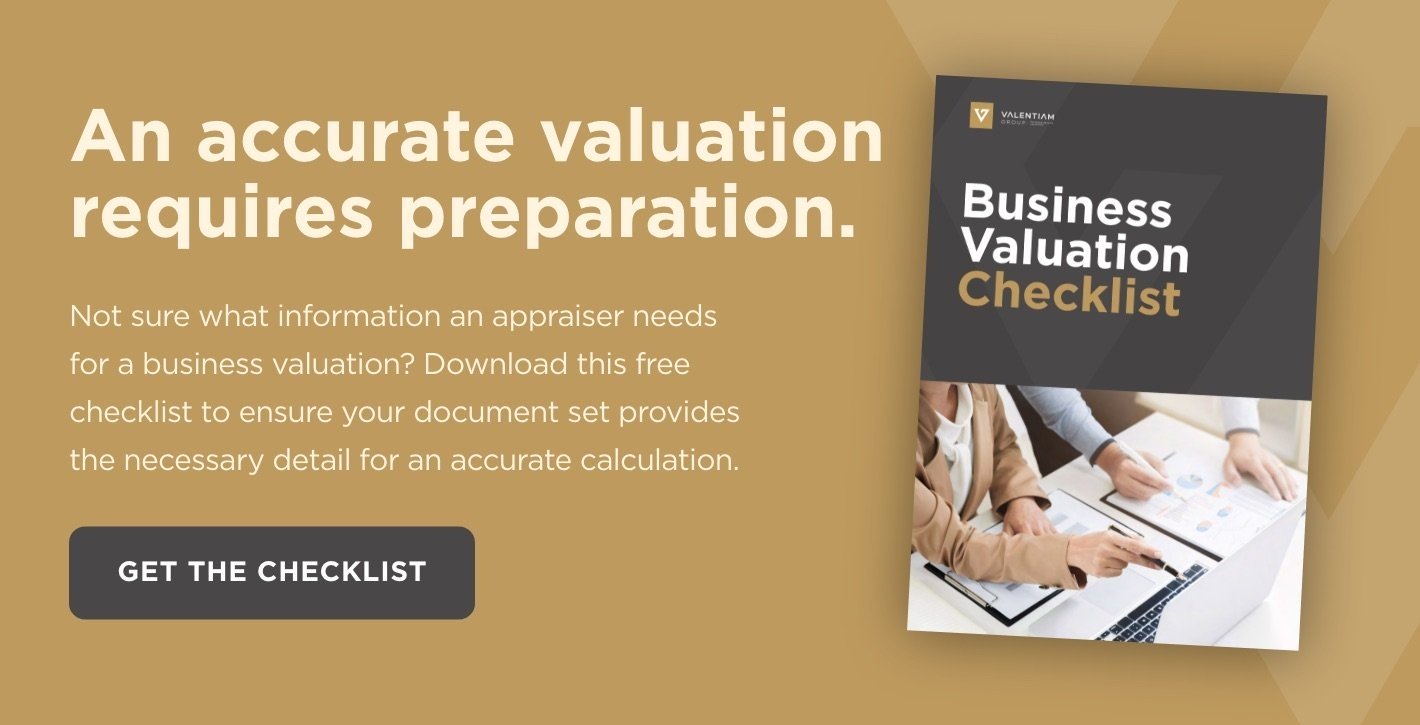Business Valuation Resources: Where To Find What You Need To Know
Posted by Valentiam Group on November 12, 2020

In most scenarios where a business valuation is needed, it’s important to have experts conduct the valuation. Without a professional valuation, tax assessment challenges are unlikely to succeed; in cases with legal ramifications, only a thorough valuation compiled by an accredited valuation expert will withstand scrutiny.
But there are some situations where do-it-yourself calculations of the value of your business may be helpful. For example, a small business owner considering retirement in several years may want to get a rough idea of the value of his business to help in personal financial planning for his retirement years; in this case, a DIY valuation works well. In this article, we’ll examine the process to follow in calculating the approximate value of your business, and provide a list of business valuation resources that may be helpful.
Determining The Valuation Method To Use
To establish a realistic value for any business, start with the financial records. Download our free Business Valuation Checklist, which provides a comprehensive list of the information you need to assemble to perform a valuation.
Once you’ve collected the financial data you’ll need to calculate a value, you need to determine which valuation approaches are most relevant. The three basic valuation approaches—the market, cost, and income methods—each have their own advantages and drawbacks.
-
Market approach
The market approach is a method of comparison that is best when valuing the entire business enterprise. The comparison is based on any available data of publicly traded stock, public or private transactions, or valuations for equity funded venture capital. For our example, using the market approach is complicated by the fact that the Subject Company is private and small. The quality of transaction data is essential and there may not be reliable data that is comparable. If any can be identified, then the procedure would be to find the best metrics for comparable companies to the Subject Company such as: price-to-earnings, price-to-sales, price-to-book, and price-to-free cash flow, and use the earnings before interest, taxes, depreciation, and amortization (EBITDA) multiple to calculate the subject company’s enterprise value.
Since each company tends to be unique in one way or another, the market approach provides at best an estimation of value. For the purposes of our example, however, that may be good enough, if the data needed to complete a market approach valuation is available.
-
Cost approach
The cost approach relies on the principle of substitution, and is best to value individual parts of a business enterprise. The cost approach is performed by calculating what it would cost to re-create or replace the Subject Company from the ground up, using current values for materials, labor, and equipment. If the Subject Company owns a manufacturing plant, for example, the cost approach would involve calculating what it would cost in materials and labor to construct a plant designed for the same purpose and the cost of the machinery needed for manufacturing the product. Once the replacement cost for all assets has been calculated, it is adjusted for depreciation to arrive at the current replacement value less depreciation for the Subject Company.
The primary drawback to the cost approach is that it is difficult to capture the value of intangible assets, like goodwill and customer relationships. Additionally, the cost approach requires a lot of reliable data and calculations, and a substantial amount of time to complete. While it provides a more solid indication of value than the market approach, since it relies on current market costs rather than comparison to companies that may differ in important respects, it only provides a value for the company’s tangible assets. A company that is a going concern is likely to be worth substantially more than just the sum of its tangible assets.
-
Income approach
The income approach is the best approach to value an income-producing enterprise. It is based on the premise that the Subject Company’s present value is equal to the present value of the future cash flows it will provide through its remaining life. To calculate the value using the income approach, first estimate the future cash flows and determine the proper cost of capital that matches the risk of the cash flows being valued. This begins with a thorough analysis of the business enterprise, then the calculation of expected changes in operating expenses, taxes, and working capital, and free cash flow. Finally, calculate the weighted average cost of capital (WACC), and calculate the present value of the estimated future cash flows.
The biggest drawback to the income approach in private company valuation is that the calculated value is sensitive to assumptions about the forecast period, the cost of capital, and the terminal growth rate. Small changes in these key assumptions can have substantial impact on the derived value, and projections are tricky..
The approach or approaches most appropriate for establishing the value of your company will rely on the purpose of the valuation, the availability of pertinent data, your ability to properly use the data in calculations, and your ability to make reasonable projections.
All business valuations begin with an analysis of company financials. Download our free Business Valuation Checklist to learn the information needed for a valuation.
Business Valuation Resources
The following business valuation resources may be useful in performing a valuation of your business:
Professional business valuation organizations
Several professional business valuation organizations train and certify members in business valuation. In a previous article, we detailed the requirements for certification by the various organizations. Publications and other business valuation resources from these organizations may be helpful if you are doing a valuation of your business.
American Society of Appraisers (ASA): ASA certification is considered the gold standard for business appraisers, requiring the most experience and education. The Society awards the Accredited Senior Appraiser (ASA) credential.
CFA Institute: The CFA Institute awards the Chartered Financial Analyst (CFA) credential. The CFA designation goes beyond business valuation to include portfolio management and other areas of finance and valuation.
National Association of Certified Valuators and Analysts (NACVA): NACVA credentials can be attained by anyone with a CPA or business degree who has substantial business valuation experience and passes the CVA exam. Those who meet the requirements are awarded the Certified Valuation Analyst (CVA) designation.
Professional standards organizations
The Appraisal Foundation: The Foundation publishes the Uniform Standards of Professional Appraisal Practice (USPAP) annually.
Financial Accounting Standards Board (FASB): FASB promulgates and publishes financial accounting and reporting standards. FASB statements of particular interest for business valuation are SFAS 142 (Goodwill and Other Intangible Assets) and SFAS 141 (Business Combinations).
International Accounting Standards Committee Foundation (IFRS): The IFRS promulgates and publishes international financial reporting standards.
International Valuation Standards Council (IVSC): The IVSC is a non-profit that formulates and publishes the International Valuation Standards for valuation of real property and businesses.
Industry and business type classification
Use these accepted industry classification systems to identify the type of business or professional practice if you plan to value your business using the market approach, so you’ll be making comparisons to businesses most similar to your own.
North American Industry Classification System (NAICS)
Standard Industrial Classification (SIC)
Market analysis resources
Moody's economy.com: Moody’s is a good source for industry statistics, forecast data, and broad economic analysis.
SEC EDGAR database: Business sales statistics, merger and acquisition activity filings, and data on acquisitions of private firms by public companies can all be found in the EDGAR database.
Government resources
Key economic and demographic data compiled and published by U.S. government agencies can be found on the following agency websites:
Bureau of Economic Analysis (BEA): This subunit of the U.S. Department of Commerce collects, analyzes, and publishes regional and national economic statistics.
Bureau of Labor Statistics (BLS): The BLS is a subunit of the U.S. Department of Labor, and compiles information about employment, compensation, and industry outlook data.
U.S. Census Bureau: The Census Bureau collects and publishes key demographic, economic, and housing data.
Internal Revenue Service (IRS): The IRS publishes guidelines and rulings for business valuation.
Securities and Exchange Commission (SEC): The SEC maintains public company filings in the EDGAR database, as well as filings on tender offers and mergers and acquisitions of private companies.
Valentiam also maintains a library of free business valuation resources, including the Business Valuation Checklist you’ll need to start your valuation of your business.
Need a professional valuation of your company?
It’s crucial to have a sound understanding of the value of your business assets. Incorrect assumptions about value can cost your business if they lead to the adoption of misguided strategies.
The world’s leading corporations trust Valentiam specialists to provide expert value opinions for all business assets—and we can do the same for your business. Talk to us about your unique situation; we can help you determine the value of your company and strategies to enhance it.
Topics: Business valuation
Related Posts
EBITDA Multiples By Industry: An Analysis
EBITDA multiples by industry indicate growth, profitability, and stability of profits in various sectors—and are a quick and easy way to estimate value.
Valuation Methods: A Guide
Different types of business valuation methods are suited to specific needs. Here are the three primary types of valuation techniques and when they should be used.


